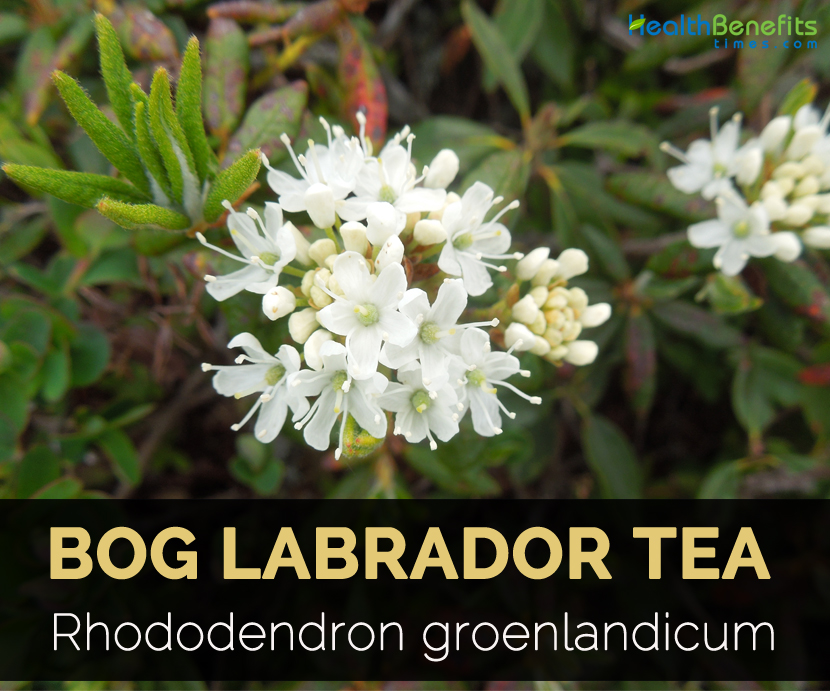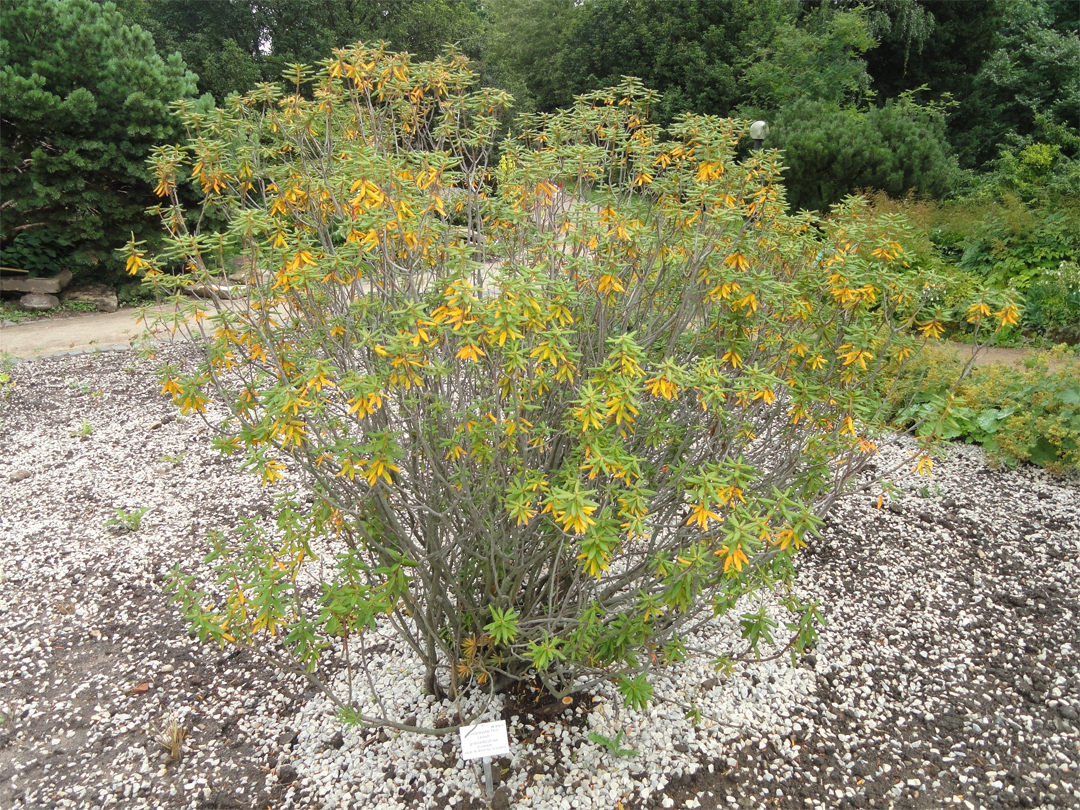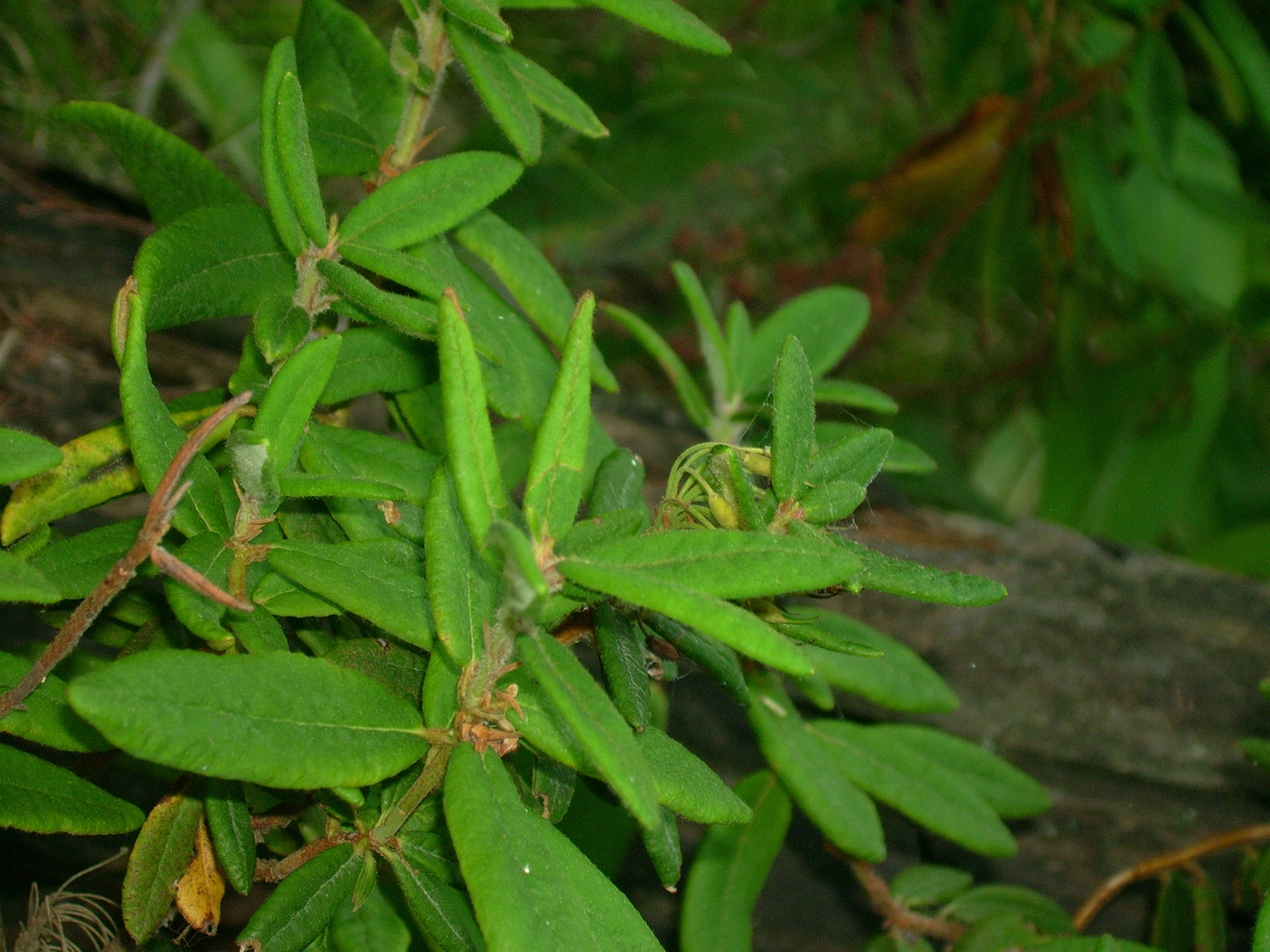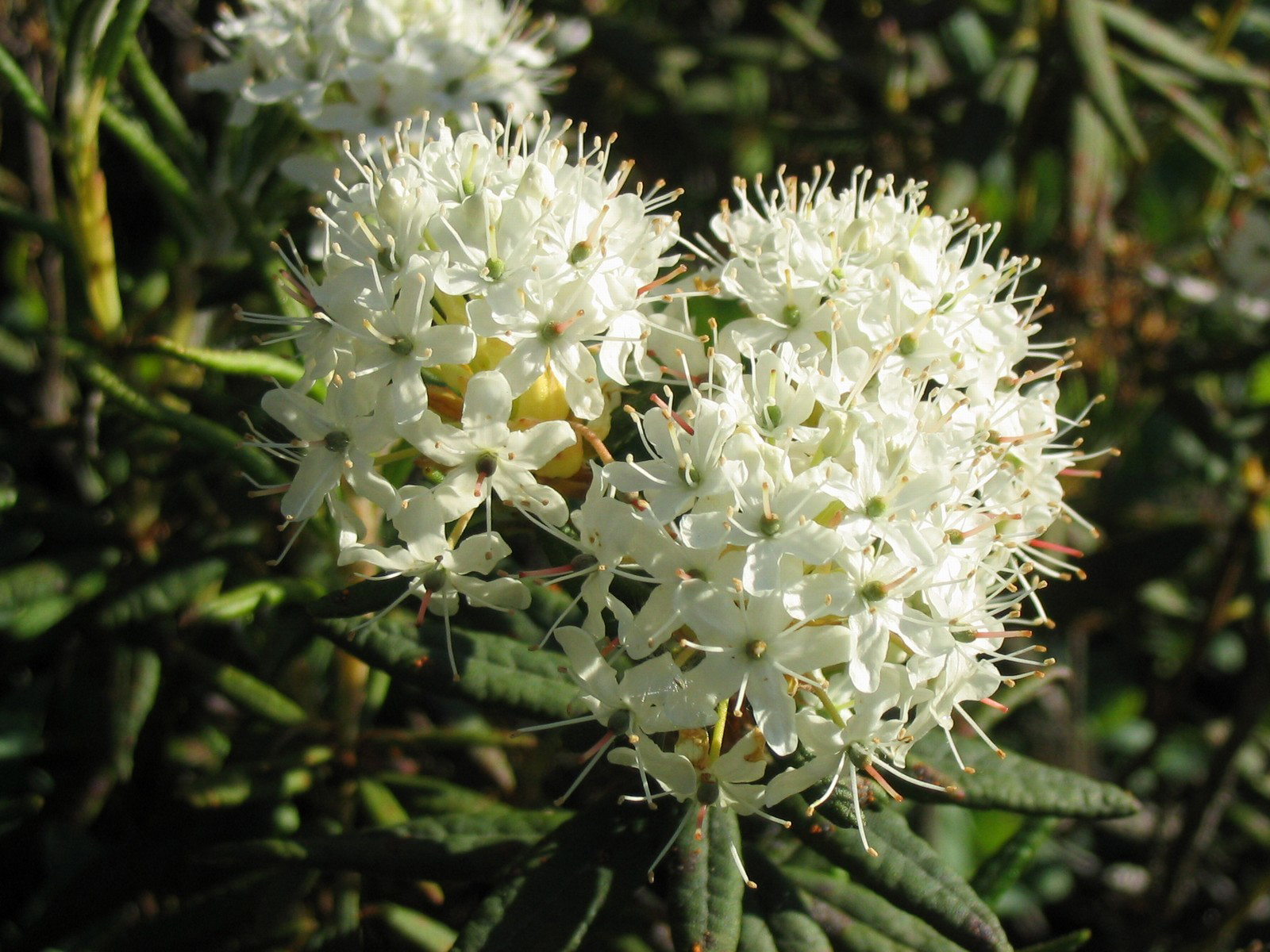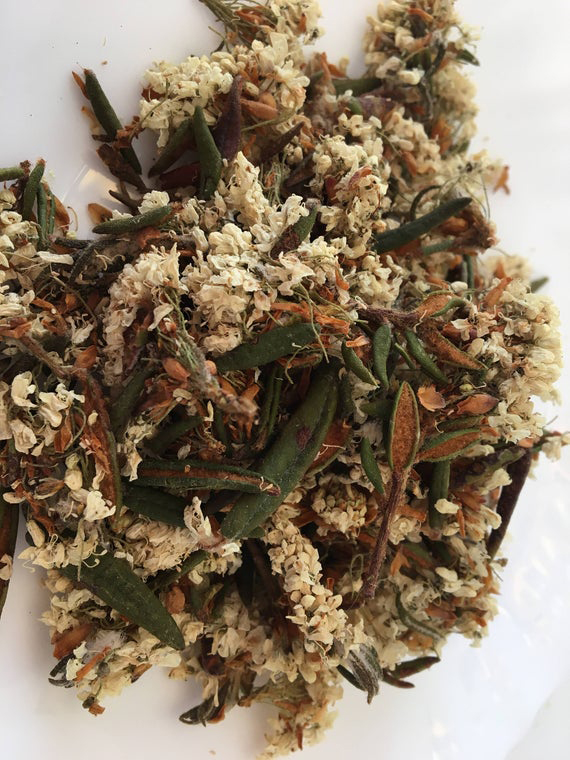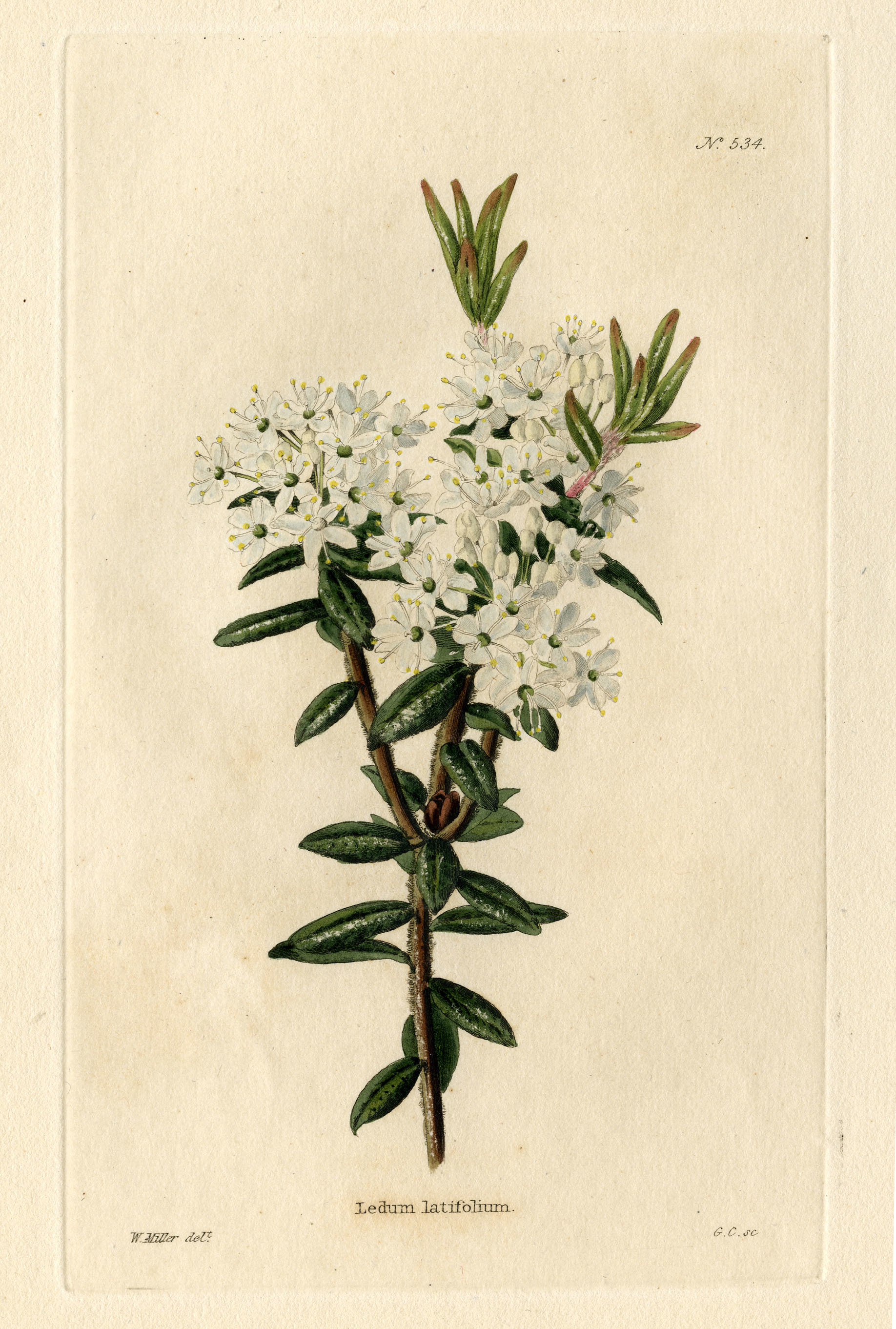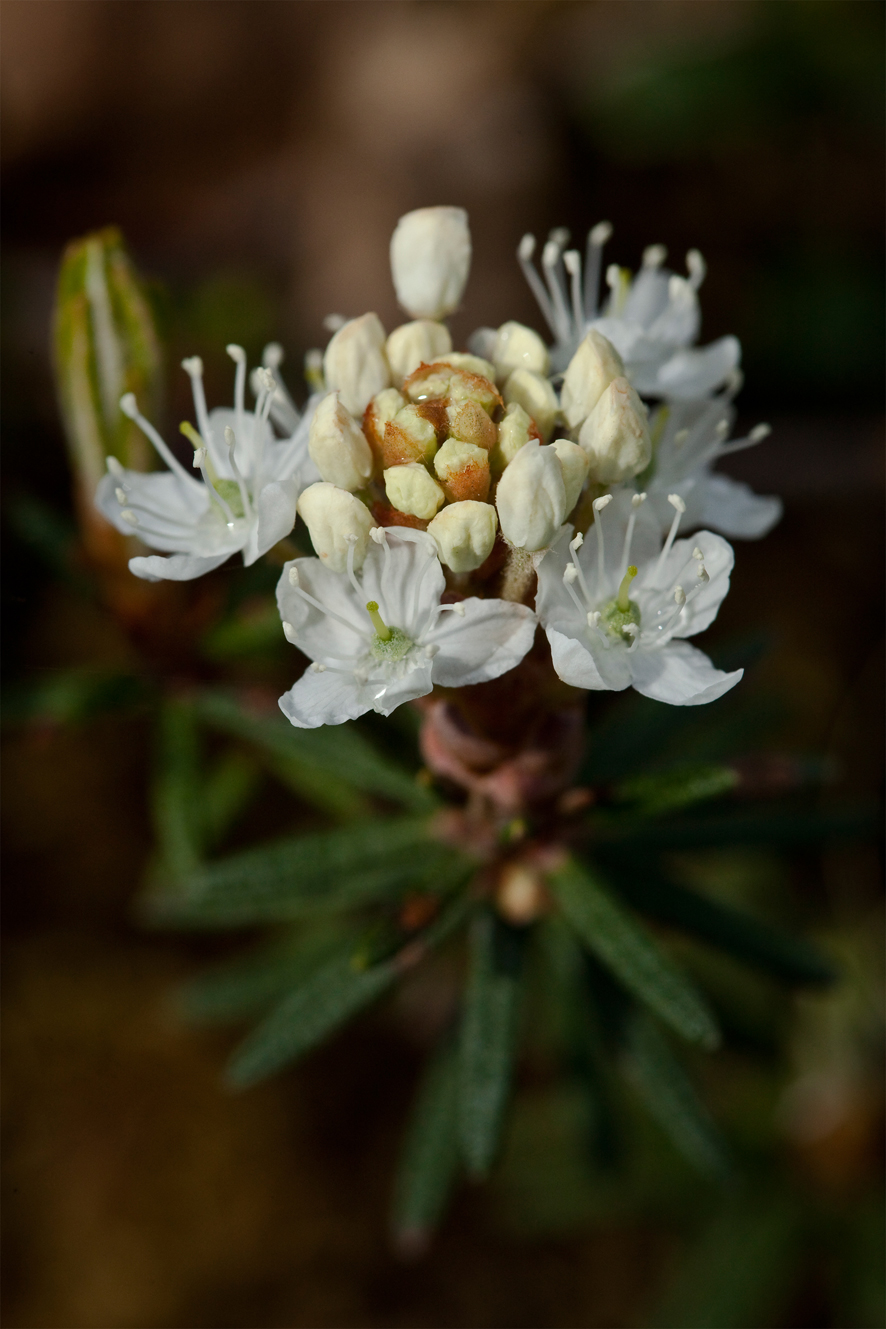| Bog Labrador Tea Quick Facts | |
|---|---|
| Name: | Bog Labrador Tea |
| Scientific Name: | Rhododendron groenlandicum |
| Origin | Native to North America |
| Shapes | Fuzzy capsule |
| Name | Bog Labrador Tea |
|---|---|
| Scientific Name | Rhododendron groenlandicum |
| Native | Native to North America |
| Common/English Name | James Tea, Wild Rosemary, Marsh Tea, Continental Tea, Indian tea, Hudson Bay tea, Swamp tea, Northern Canada Hudson’s Bay Tea, St. Jamestea, Woolly tea, Settler’s tea,Greenland Labrador tea, Tundra tea, The´du Labrador,the´veloute´, Bois de savane, Le´don a`feuilles larges |
| Name in Other Languages | English: Labrador-tea, Bog Labrador tea, Common Labrador tea, Greenland Labrador tea, Labrador tea; Swedish: Bredbladig skvattram; French: Thé du Labrador, Lédon du Groenland, Thé velouté |
| Plant Growth Habit | Evergreen shrub |
| Plant Size | 50 cm tall |
| Bark | Smooth brown |
| Stem | Erect to prostrate, 1-1/2 to 3 feet long |
| Leaf | Alternate, simple, 20–60 millimetres long, 3–15 millimetres broad |
| Medicinal part | The leaves |
| Flower | White |
| Fruit shape & size | Fuzzy capsule |
Health Benefits of Bog Labrador Tea
- Respiratory health
Bog Labrador Tea is helpful for treating respiratory conditions such as coughs, bronchitis, flu cold and congestion. Sore throats are common symptoms of types infections and anti-inflammatory properties found in Bog Labrador Tea neutralize or eliminate that discomfort.
- Kidney health
Labrador tea is used for treating kidney disorders and detoxifies body as it has mild diuretic properties and flush system when overloaded with toxins. It helps to slow down growth of kidney stones and lowers inflammation in that organ.
- Digestive system
Labrador tea is useful for indigestion and upset stomachs. When consumed in excess can cause upset stomach. This tea has active ingredients such as sesquiterpenes and tannins which provides calming effect on bloating, cramping, constipation and diarrhea.
- Skin health
The diluted or weak form of tea is recommended for drinking. The strong pot of this tea is beneficial for skin health. The antioxidant and astringent properties is present in this tea so when applied topically, it is effective for psoriasis, eczema, irritation, leprosy and inflammation.
- Immune Health
Bog Labrador Tea has moderate amounts of Vitamin C which stimulates immune system and ensures that body has adequate white blood cells for protecting the body. Vitamin C is an antioxidant which eliminates free radicals that causes oxidative stress, chronic disease and inflammation.
- Cancer prevention
Research is conducted to find out the effectiveness of Labrador tea on cancerous cells. Research has found antioxidant composition of this tea with anti-mutagenic and anti-carcinogenic effects which makes it excellent preventative measure when consumed in adequate amounts.
Habitat
It is disclosed from Greenland and from every province and territory in Canada and in the northeastern and northwestern United States (New York, New England, Michigan, Pennsylvania, Idaho, Minnesota, Wisconsin, Alaska, Oregon and Washington). It grows in bogs, open tundra, musklegs and occasionally on wet shores and rocky alpine slopes.
Uses
Very useful in coughs, colds, bronchial and pulmonary affections. Sometimes used as a table tea. For internal use the infusion of 1 teaspoonful of dried leaves to 1 cup of boiling water in wineglassful doses as needed for the control of the above mentioned.
Externally
A strong decoction has been recommended for external use as a remedy for itching and exanthematous (eruptions accompanied by fever) skin diseases.
Homoeopathic Clinical
Tincture of dried small twigs and leaves collected after flowering begins; tincture of whole fresh plant—Ascites, Asthma, Bites, Black eye, Boils, Bruises, Deafness, Ear (inflammation of), Eczema, Erythema nodosum, Face (pimples on), Feet (pains in, tender), Gout, Haemoptysis, Hands (pains in), Intoxication, Joints (affections of, cracking in Menier’s disease), Pediculosis, Prickly heat, Punctured wounds, Rheumatism, Skin (eruption on), Stings, Tetanus, Tinnitus, Tuberculosis, Varicella, Whitlow, Wounds.
Russian Experience
The common Russian name is Bogulnik but literature gives it another, Herba Ledu, which is very close to Canadian Ledum palustra, or Ledum marshland. Bogulnik sometimes covers miles of marshland in European Russia, Siberia and the Far East, making it impossible for other plants to invade this strong shrub abode.
The young leaves and twigs are collected in August and September. Care must be observed when drying as one of the various volatile ether oils it contains is 7½ per cent Ledum; the strong aroma from which could seriously affect the heart if one is in too close confinement during this plant drying stage.
Folk Medicine
Medical literature gives full credit to Folk Medicine though it is not fully experimented clinically. Leaves and twigs are officially collected for state institutes and sold to pharmacies and dispensaries.
Uses
Accommodates Coughs, Bronchitis, Bronchial asthma, Tubercular lungs, Stomach sickness, Headache, Kidney and weak Bladder, Rickets, Diarrhoea, Rheumatism (internally, and as a liniment or ointment), Pains in the chest, Scrofula, Scaby dandruff (blanketed on the scalp, or in patches). Additional: fertility, infections, tightness of breath. Can cure Bronchitis in two weeks. Recommended as a tea decoction of 1 oz. tea to 2 pints boiling water; drink as required, a mouthful at a time.
Externally
Russian Homoeopaths boil the flowers in fresh butter making an ointment for skin diseases, bruises, wounds, bleeding and rheumatism.
Culinary uses
- Leaves and flowers are used to prepare herbal teas.
- Fresh leaves are chewed.
- Use the leaves as a seasoning for fish and meats.
Traditional uses
- It is used to strengthen stomach, relieve head and promote perspiration.
- Apply it externally to contusions, gangrenes and excoriations.
- Leaves are used for treating rheumatism, asthma and burns.
- Drink it as tea or juice for treating stomach flu, diarrhea, bad breath, chills, difficulty urinating and pneumonia.
- Denyaave of Alaska use leaves tea for upset stomach, ease arthritis pain and ease heartburn.
- Flower tea is used to combat cold.
- Cooled tea is used as a wash for skin problems and gargle for sore throats.
- Use it externally for treating various skin problems.
- It is externally used as a wash for burns, itches, ulcers, stings, chapped skin and dandruff.
- The ointment made from powdered leaves or roots are used for treating cracked nipples, ulcers, scalds and burns.
Precautions
- Frequent intake may cause diuretic effect, intestinal ailment, vomiting, dizziness, drowsiness and exhaustion.
- Pregnant women should avoid it as it may lead to abortion.
How to make Labrador tea
- Take one to two teaspoonful Labrador tea leaves in a teapot.
- Pour 2-3 cups of boiling water over the leaves.
- Steep for five minutes.
- Strain the mixture to remove the leaves.
- Add flavor with lemon, sugar, or honey
References:
https://www.itis.gov/servlet/SingleRpt/SingleRpt?search_topic=TSN&search_value=520050#null
https://plants.usda.gov/plantguide/pdf/cs_legr.pdf
https://en.wikipedia.org/wiki/Rhododendron_groenlandicum
https://pfaf.org/user/Plant.aspx?LatinName=Ledum+groenlandicum
https://www.revolvy.com/page/Rhododendron-groenlandicum?cr=1
https://www.ayurtimes.com/bog-labrador-tea-rhododendron-groenlandicum/
https://www.herbalteasonline.com/labrador-tea.php
http://temperate.theferns.info/plant/Rhododendron+groenlandicumv


